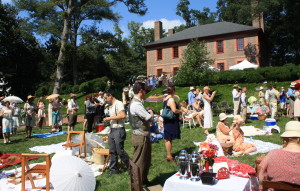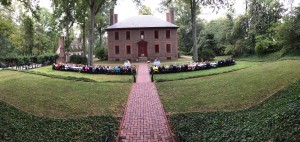Re-Awakening Wilton
by William Strollo, Director of Education and Public Relations, Wilton House Museum
A lot can change over a decade. Ten years ago, Wilton House Museum in Richmond’s West End looked like the typical local historic house museum. Rooms were crammed full of objects from a wide range of time periods, and visitors were not allowed to take pictures in the museum. Year-round visitation at Richmond’s only 18th-century plantation house museum barely broke four digits. Wilton and the museum, however, were about to enter an essential period of transition.
Traditionally interpreted as the centerpiece of Anne Harrison and William Randolph III’s 2,000-acre tobacco plantation, this stunning brick Georgian house was moved in the early 1930s from its original location 15 miles upriver to its current site by The National Society of The Colonial Dames of America in the Commonwealth of Virginia. The Virginia Dames have used Wilton as their state headquarters since the 1935, and 20 years later the house opened as a museum interpreting the Randolphs’ life at Wilton. The house’s beauty and refinement have been long admired, and, in 1958, Helen Comstock included Wilton’s finest room, its parlor, in her publication 100 Most Beautiful Rooms in America.
Over the past decade, the Wilton’s staff sought to infuse more life and accuracy into museum tours and programming. Multiple paint analyses and the museum’s first historic structures report (an ongoing project) add to the evolving scholarly understanding of the house and its ownership. New programs, including decorative arts lectures, outdoor concerts, children’s summer camps, and special holiday events, draw a broad demographic of visitors to the museum year-round. Additional initiatives such as temporary exhibitions and interpretative changes give visitors a reason to return to the museum regularly.
A mentorship program with art history students from Virginia Commonwealth University is one of the museum’s successes. Graduate and undergraduate students work with museum staff and university faculty to create exhibitions for the museum’s gallery space: the second floor central passage. The most recent collaboration involved graduate students tasked with creating an exhibition around the theme of nostalgia. The final product was an integration of contemporary art into this historic space.
In years the museum has seen significant growth in programming and visitation. Such success would not have been possible without the support of and collaboration with likeminded organizations. The Decorative Arts Trust, the Chipstone Foundation, and Virginia Commonwealth University (to name a few) help to make Wilton a significant resource to the Richmond community. Coupled with continual scholarly investigations, Wilton will continue to grow and re-examine how and why it approaches public engagement with the goal of making the visitor experience more coherent, enjoyable, and meaningful.
THE TRUST AND WILTON PARTNER ON CONFERENCE
On October 10, 2015 Wilton hosted a one-day symposium developed in collaboration with the Trust. Inspired by the Dames’ investigation of Wilton’s architectural history and the museum’s interpretive plan, the conference focused on new research on Virginia’s historic homes and decorative and fine arts. Speakers from Colonial Williamsburg, Monticello, Mount Vernon, Tudor Place, and Wilton delivered excellent presentations, and the program was very well received. Upwards of 100 participants attended, the majority of whom were new to the Trust, including more than a dozen graduate students from programs between South Carolina and Delaware. Trust members can look forward annual one-day conferences in years to come.
SAVE THE DATE
- Special Symposium
“Classical Splendor”
The Philadelphia Museum of Art
November 4, 2016 - New York Antiques Weekend
January 20-21, 2017 - Spring Symposium
Savannah
April 21-24, 2017 - Spring Study Trip Abroad
Scotland
May 14-22, 2017 - Fall Symposium
Hartford & Western Connecticut
September 2017 - Fall Study Trip Abroad
Venice and the Veneto
October 9-16 and 22-29, 2017
A lot can change over a decade. Ten years ago, Wilton House Museum in Richmond’s West End looked like the typical local historic house museum. Rooms were crammed full of objects from a wide range of time periods, and visitors were not allowed to take pictures in the museum. Year-round visitation at Richmond’s only 18th-century plantation house museum barely broke four digits. Wilton and the museum, however, were about to enter an essential period of transition.
Traditionally interpreted as the centerpiece of Anne Harrison and William Randolph III’s 2,000-acre tobacco plantation, this stunning brick Georgian house was moved in the early 1930s from its original location 15 miles upriver to its current site by The National Society of The Colonial Dames of America in the Commonwealth of Virginia. The Virginia Dames have used Wilton as their state headquarters since the 1935, and 20 years later the house opened as a museum interpreting the Randolphs’ life at Wilton. The house’s beauty and refinement have been long admired, and, in 1958, Helen Comstock included Wilton’s finest room, its parlor, in her publication 100 Most Beautiful Rooms in America.
Over the past decade, the Wilton’s staff sought to infuse more life and accuracy into museum tours and programming. Multiple paint analyses and the museum’s first historic structures report (an ongoing project) add to the evolving scholarly understanding of the house and its ownership. New programs, including decorative arts lectures, outdoor concerts, children’s summer camps, and special holiday events, draw a broad demographic of visitors to the museum year-round. Additional initiatives such as temporary exhibitions and interpretative changes give visitors a reason to return to the museum regularly.
A mentorship program with art history students from Virginia Commonwealth University is one of the museum’s successes. Graduate and undergraduate students work with museum staff and university faculty to create exhibitions for the museum’s gallery space: the second floor central passage. The most recent collaboration involved graduate students tasked with creating an exhibition around the theme of nostalgia. The final product was an integration of contemporary art into this historic space.
In years the museum has seen significant growth in programming and visitation. Such success would not have been possible without the support of and collaboration with likeminded organizations. The Decorative Arts Trust, the Chipstone Foundation, and Virginia Commonwealth University (to name a few) help to make Wilton a significant resource to the Richmond community. Coupled with continual scholarly investigations, Wilton will continue to grow and re-examine how and why it approaches public engagement with the goal of making the visitor experience more coherent, enjoyable, and meaningful.
THE TRUST AND WILTON PARTNER ON CONFERENCE
On October 10, 2015 Wilton hosted a one-day symposium developed in collaboration with the Trust. Inspired by the Dames’ investigation of Wilton’s architectural history and the museum’s interpretive plan, the conference focused on new research on Virginia’s historic homes and decorative and fine arts. Speakers from Colonial Williamsburg, Monticello, Mount Vernon, Tudor Place, and Wilton delivered excellent presentations, and the program was very well received. Upwards of 100 participants attended, the majority of whom were new to the Trust, including more than a dozen graduate students from programs between South Carolina and Delaware. Trust members can look forward annual one-day conferences in years to come.



